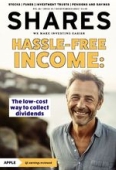Archived article
Please note that tax, investment, pension and ISA rules can change and the information and any views contained in this article may now be inaccurate.
Hassle-free income: The low-cost way to collect dividends

The income attractions of stocks are being tested right now thanks to increased interest rates, allowing you for the first time in years to generate a decent return on cash in the bank.
However, rates are approaching their peak and are still short of the latest rate of UK inflation, making a case for looking to the financial markets where a range of asset classes offer the potential for both yield and capital appreciation.
In addition, savers who put their money in savings accounts which are not Cash ISAs risk going over the tax-free amount you can receive in interest on your savings. AJ Bell research suggests higher-rate taxpayers with anything upwards of £9,525 of cash in the best easy-access account will be faced with a tax bill.
DIVIDEND DIVERSIFICATION CAN LIMIT THE RISKS
The risk of chasing higher-yielding investments, particularly stocks and shares, is dividends are not set in stone and can be cut or even cancelled all together. Often a high yield is a sign a company’s dividend is looking vulnerable and the market has marked the shares lower in the expectation of a reduction or suspension of the payout. The value of investments can go down too, whereas cash is guaranteed up to £85,000 by the Financial Services Compensation Scheme.
A solution to this is diversification – buying an income fund with a range of different holdings. This means if one dividend is cut or one investment goes wrong for any other reason the impact on your overall income is modest.
However, with every drop of income important right now you do not want to be giving away too much in fees. This makes the case for looking at exchange-traded funds which, typically, benefit from lower ongoing charges, meaning you get to keep more of the cash paid out by your investments yourself.
In this feature we explain how to go about building a portfolio of income-generating ETFs designed to achieve a good level of income while also providing some growth.
SCREENING FOR HASSLE-FREE INCOME
To help produce our list of names we used ETF website JustETF to identify some of the highest-yielding funds. We confined our search to products offering a yield of at least 5%. It is worth noting, typically, with individual shares you would look at the yield based on consensus dividend estimates for the future.
However, there are no forecasts for dividend payments from ETFs so we can only look at historic yields based on what they have paid out over the preceding 12-month period. What they pay out in the future could be higher if, in turn, the underlying holdings generate a higher income.
The ETF identified through this exercise with the biggest yield is Global X Super Dividend (SDIP) which yields an eye-catching 13%.
It tracks the Solactive Global SuperDividend index, which comprises global companies with dividend yields of more than 6% and less than 20% and a market value of at least $500 million with the highest yielders within that universe making the cut. It is rebalanced on a quarterly basis. This process arrives at an obscure list of names and the performance of the index of late suggests you may be getting regular income but chalking up significant losses in the meantime.
How income-based ETFs work
ETFs are normally set up for either income or accumulation. Income ETFs pay out distributions to holders as cash, while accumulation ETFs effectively reinvest the dividends for you. So, you need to make sure you buy the right version of the ETF if you want to receive the income as cash.
Some ETFs don’t offer a choice of income or accumulation versions of their fund. If there is no choice, it typically means any dividends will be paid out in cash.
If the ETF invests directly to replicate the performance of the index it tracks then it will receive the dividends associated with the underlying holdings. If the ETF distributes income, the dividends are collated in a cash account and usually paid out on a quarterly, semi-annual or annual basis.
The situation is a little more complex for swap-based ETFs. They receive the performance of the total return index from their swap provider (a broker or investment bank). This includes dividend payments as well as any price changes in the underlying companies. The dividend portion is then separated out and delivered to investors.
For our selections we have focused on products whose performance has at least been steady while they provide that regular stream of income. Read on to discover our four picks – each of which distribute their income rather than reinvesting it. Their average yield is 6.7% and their average ongoing charge is 0.41%.
WisdomTree Emerging Markets Equity Income (DEM £11.13
Dividend yield: 7.4% Ongoing charge: 0.46%
Emerging markets are typically higher-risk and more volatile than developed markets, but this is reflected in the generous yields available. Firms in these markets which pay dividends are likely to be steadier operators and the five-year performance of this product is solid. It tracks a basket of emerging markets stocks with high yields. Applying an ESG (environmental, social and governance) and risk-management filter to the wider universe, the top 30% of names by dividend yield (based on dividends paid over the previous annual cycle) are selected. The index is rebalanced once a year.
As well as enjoying generous income in the short term, you may also benefit from dividend growth as these markets mature, as Kepler observes: ‘While dividends tend to be more variable in emerging markets, for long-term investors there is the potential for changing dividend cultures to lead to steadily rising payout ratios in multiple markets which have historically prioritised dividends less.’
WisdomTree Europe Equity Income (EEI) £10.16
Dividend yield: 6% Ongoing charge: 0.29%
This is a small fund, which can sometimes be a risk with ETFs through lower liquidity and the risk it could be closed due to lack
of interest, but this product has been around since 2014 so we
feel these risks are limited.
It applies the same criteria as the emerging markets product above, using risk management and ESG criteria and then identifying the top 30% of dividend payers across Europe including the UK market. Dividends tend to be more generous on this side of the Atlantic and in particular among stocks listed in London, which account for a little under a quarter of the portfolio.
According to Computershare’s UK Dividend Monitor, regular dividends excluding one-off special payments totaled £26.6 billion in the third quarter up 2.4% year-on-year on an underlying basis. The mining sector made by far the biggest negative contribution to the UK total in the period, knocking nearly five percentage points off the quarter’s growth rate, with dividends falling by almost a quarter year-on-year (-23.6%) as lower commodity prices impacted profits. However, growth was significantly better outside the mining sector, reaching 7.2% on an underlying basis.
VanEck Morningstar Developed Markets Dividend Leaders (TDGB) £29.82
Dividend yield: 5.1% Ongoing charge: 0.38%
As well as dividend yield, there are advantages to looking for dividend growth. This can help your income stream at least partly keep pace with inflation and growing the payout is a marker of a quality business which could well deliver strong capital growth too. It is notable this ETF has the best five-year performance of our quartet.
The Morningstar Developed Markets Large Cap Dividend Leaders index tracks the performance of companies which display consistency and sustainability in dividend payment patterns and is composed of the 100 highest-yielding securities which satisfy the screening criteria. One of these is for dividend growth, and names in the basket include Ford Motor (F:NYSE), IBM (IBM:NYSE) and French pharma outfit Sanofi (SAN:EPA). The list is rebalanced twice a year.
Invesco Morningstar US Energy Infrastructure MLP Dist (MLPP) £37.60
Dividend yield: 8.1% Ongoing charge: 0.5%
As well as diversifying into a collection of different stocks, it can make sense to consider other asset classes too. Infrastructure, as a long duration asset, has been hit by an increase in interest rates feeding through into higher discount rates.
Two key elements make up the discount rate – the risk-free rate, which is typically taken as the yield on government bonds, and the risk premium which reflects the risk associated with investing your money. The risk-free rate has moved materially higher, but with rate-hiking cycle nearing its peak this is potentially less of a consideration going forward and this product, which invests in US energy infrastructure, looks a reliable source of income.
It achieves exposure to this asset class through MLPs (master limited partnerships) which trade on US exchanges like shares. They offer a fee-based ‘toll-road’ type business model with contracts lasting several years, giving them a fairly stable and predictable stream of revenue. They have a lower correlation to volatile energy prices than commodity producers because they generate the majority of their revenue based on the usage of assets such as pipelines, storage facilities and terminals.
Important information:
These articles are provided by Shares magazine which is published by AJ Bell Media, a part of AJ Bell. Shares is not written by AJ Bell.
Shares is provided for your general information and use and is not a personal recommendation to invest. It is not intended to be relied upon by you in making or not making any investment decisions. The investments referred to in these articles will not be suitable for all investors. If in doubt please seek appropriate independent financial advice.
Investors acting on the information in these articles do so at their own risk and AJ Bell Media and its staff do not accept liability for losses suffered by investors as a result of their investment decisions.
Issue contents
Feature
Great Ideas
Investment Trusts
News
- Apple wins over jumpy investors despite China growth worries
- Fortinet slumps nearly 20% on weak revenue and outlook
- Hipgnosis looks to steady ship with appointment of ex-Roundhill chair after suspending dividends
- Ferrari speeds to fresh highs following another record quarter
- Does a strong start to November for shares signal the start of a Santa rally?
- Ball deal and buybacks in focus for BAE Systems amid Middle East conflict

 magazine
magazine








